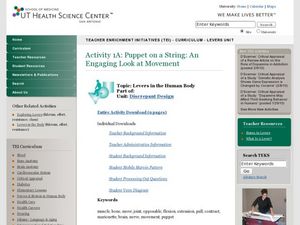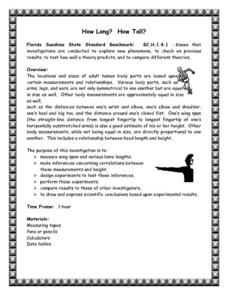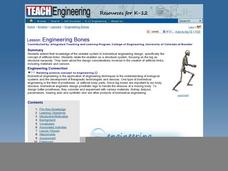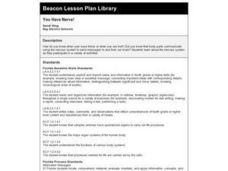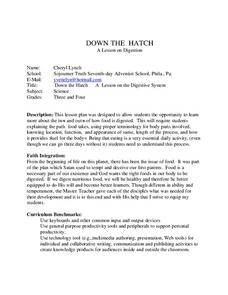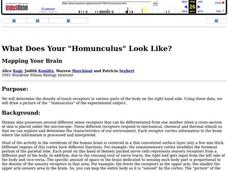Curated OER
Bioethics: Debates in Human Genetics
Students, in groups, research and prepare a debate regarding various bioethical situations. After the debates, each student prepares a ortfolio outlining their own personal opinions.
Curated OER
TE Activity: Sound Line
Students investigate the decibel readings of various noises. They determine why high-level readings damage hearing. Students arrange sound from the lowest to highest decibel levels when they written on a piece of paper.
Curated OER
Nervous System
Get to know the body's central nervous system through an engaging game of nervous system telephone. But this isn't your average game of telephone. Here, pupils must find a way to communicate a message to the brain without speaking....
Curated OER
Sense of Hearing
Create a graphic organizer to review parts and systems of the body, then present a new topic. Special education students grades 3-5 learn about the sense of hearing. They draw parts of the ear, sign a song, read Perk Up Your Ears, and...
Curated OER
Skin: The Behavior and Health Connection
Middle schoolers explore how personal behavior can affect health, especially the health of your skin. They become better aware of how their personal behavior and the environment can have a considerable impact on their health in general....
Curated OER
Brain Watching
Students identify the different parts of the nervous system. In this biology lesson, students research methods to diagnose and cure neurological disorders. They present their report to class.
Curated OER
Muscle Movements
High schoolers participate in a game to identify major muscle groups in the body and gain an understanding of muscle functions.
Curated OER
Puppet on a String: An Engaging Look at Movement
Pupils examine how muscles can work together with joints. In this movement lesson students use a marionette to observe how muscles work.
Curated OER
How Long? How Tall?
Seventh graders investigate the parts of the human body and examine the symmetry of body parts like arms and legs. They measure the body parts and take individual height and weight to compare the quantities. Student examine whether the...
Curated OER
Engineering Bones
Pupils identify the features of a prosthetic limb and explain how engineers are involved in the prosthetic design. In this bone engineering lesson students describe the design criteria that goes into choosing the materials that go...
Curated OER
Module 2: "Keeping Teeth Bright and Healthy"
Students become aware why cleaning their teeth helps keep them strong and healthy. They study basic brushing techniques, what plaque is, how a cavity is formed, why having clean teeth is an important part of having a clean body and why...
Curated OER
Explore Fish
Read Animals Called Fish with your young Spanish language learners and talk about the different parts of a fish. After teaching terms like huesos, columna vertebral, aletas, escamas, etc, Learners...
Curated OER
Using Light and Shadow to Create a Sense of Character
Students heighten awareness and mastery of the subtle factors of drawing technique. Activities focus solely on the human figure, particularly the face. students list 5 of elements of light and shadow which affect portrayal of character...
Curated OER
Beautiful Bovine
Looking for a fun and interactive way to explore bovine biology? Learners read a brief informational text (included for printing) before participating in several cross-curricular activities. First, grab their attention with a hilarious...
Curated OER
Alcohol Addiction and Its Effect on the Body
Ninth graders use the Internet to research the liver and the effects of alcoholism. In this alcohol addiction lesson students divide into groups and get information on their topic.
Curated OER
You Have Nerve!
Fourth graders investigate the nervous system and how it communicates messages to and from the brain.
Curated OER
Down The Hatch
Students investigate how food is digested. They go through the terminology of the digestive system and follow the steps to it from beginning to end. Students use technology tools to create presentations to illustrate the functions of the...
Curated OER
BOTTOMS UP?
Students view a Magic School Bus video that teaches about the digestive system. They create a life-size model of the digestive system.
Curated OER
Levels of Organization
Middle schoolers read and complete a worksheet about the levels of organization of living things from cells to organ systems. They use a text book and the "Cells R Us" worksheet included to create a metaphor for each of the levels. ...
Curated OER
Animals Piece by Piece
Learners sort organisms and objects into groups according to their parts and describe how the groups are formed.They identify body parts of animals from puzzle pieces, assemble the puzzle, and name the animal.
Curated OER
Insect Safari
Third graders name and identify three body parts of an insect, identify the characteristics that insects have six legs and one pair of antennae and categorize insects as to whether they are helpful or harmful.
Curated OER
The Cassini Robot
Pupils compare the functions of a robot to that of the human body. In this technology lesson, students identify the important components of the Cassini robot that would enable it to carry out space missions. They design and build their...
Curated OER
The Science of Weather: Humidity makes air feel even hotter.
Students examine the effects of heat and humidity. In this weather lesson, students read a chart to determine the effects heat and humidity can have on the human body. This lesson includes an optional extension activity using a newspaper.
Curated OER
What Does Your "Homunculus" Look Like?
Students investigate the density of touch receptors in various parts of the body. They discover how the body senses various stimuli, then maps a picture of the "homunculus" of the experimental subject.







